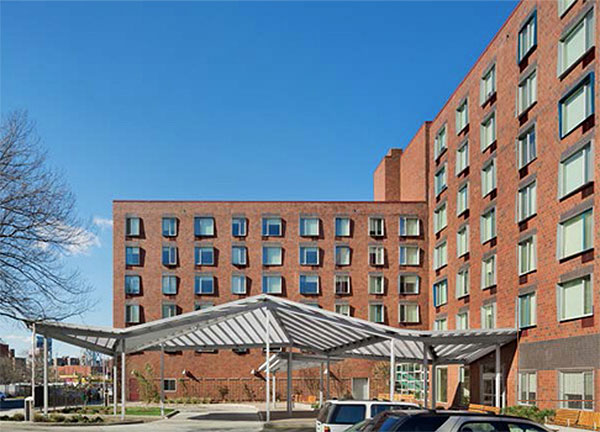
(photo: WSFSSH)
The conversation around affordable housing in New York largely focuses on ensuring that working people can continue to live here.
Bus drivers, healthcare workers, elementary school teachers -- too few of the people who fulfill some of our city’s key services can afford a market-rate one-bedroom apartment within city limits. It’s inarguably a crisis that threatens the fundamental quality of our city, as well as its continued economic growth.
But another tidal wave is growing that deserves equal attention: as baby boomers retire and reach old age, a growing number of seniors -- on fixed incomes, many of them with ongoing health care needs -- are finding themselves homeless.
The population of single adults 65-and-older living in shelters has doubled since January 2014 to over 1,400 people. A UPenn study estimated that this population could grow to nearly 7,000 by 2030.
Homelessness hits seniors particularly hard: without a permanent address, it becomes harder to secure necessary medications, and the likelihood of senior abuse rises significantly. Social isolation has cascading impacts on emotional and physical wellbeing.
Homelessness increases an individual’s risk of mortality, and homeless individuals 50- to 62-years-old often have healthcare needs more likely in later age -- like problems with vision, mobility, and hearing, as well as falls.
How we address this crisis gets at the heart of who we are as a city.
The Mayor’s Office and City Council have made some inroads in building affordable housing for independent, low-income seniors, with over 989 units built to date during the de Blasio administration and another 2,986 in the pipeline, which will expand to roughly 5,000 units -- but homeless seniors have very specific support needs, and more can be done to develop and operate permanent affordable supportive housing catered to them.
A 320-unit, three-building affordable senior housing campus known as Tres Puentes/Borinquen Court, which opened at the end of May and is operated by long-time supportive housing developer the West Side Federation of Senior and Supportive Housing (WSFSSH), which I run, may provide a model.
Diverse groups in the South Bronx worked together to ensure the successful navigation of some of the city’s most complex urban development challenges in service of the project, which, now that it’s open, not only provides top-tier services for seniors, but does so in a space that the neighborhood can be proud of.
Here’s three key lessons we’ve learned through the development and operation of this campus that may be replicable for other senior housing in the Bronx and across the city:
First, for successful development, create strong local partnerships.
It’s an unfortunate reality of our city that residential communities can be suspicious of new affordable housing. By bringing everyone to the table from day one, from residents to developers, community members and government, you can build a coalition to support new development in service of area seniors. You can address fears before they become real roadblocks to bringing needed housing online.
Strong coalitions are also more likely to successfully troubleshoot some of New York’s most vexing challenges on the road to development -- like overcoming infrastructural surprises that are the result of historic disinvestment and comprehensively addressing environmental remediation needs.
Second, embrace bold design choices.
Shirking the institutional aesthetic to weave in design elements practiced more traditionally in market-rate residential projects typically reserved for individuals of higher socioeconomic status has multiple benefits -- from adding architectural diversity into the neighborhood to showcasing to residents that their comfort matters.
Bright colors and double-height ceilings make the space cheerful and welcoming, a place for seniors to feel elevated and connected to their community. The building is adorned with a corrugated veneer popular in modern design, evoking the neighborhood’s industrial past and creating an inviting façade.
Aesthetics matter, not just to residents and staff, but to the neighbors who pass the site every day. Thoughtful aesthetics are a reminder that affordable housing can be an integral part of our communities, that its residents are our neighbors, worthy of identifying with and fighting for.
Third, invest in unique social services for seniors.
Housing homeless seniors is a start; but to help truly end the homelessness crisis among seniors, comprehensive social services that get at the unique needs of the age group are a must. These social needs can only be addressed in supportive housing, of which there is so little.
Every angle of seniors’ social needs must be addressed as part of any new supportive housing development.
Financial coaching can not only prevent abuse and scams, but help navigate local and national systems for health care and entitlements.
Exercise regimens should be catered to the age group, focusing on muscle retention and flexibility as well as other medically-indicated activities.
On-staff social workers and partner health providers must specialize in senior issues like dementia and depression, and complex social challenges with adult children and friends.
But it’s not just addressing crisis; with proper support, today’s seniors can live fuller, longer lives. By investing in smart development to address seniors’ needs, we can ensure that they live lives more connected to their communities.
With a commitment to high-quality housing New York can lead the way in empathetic and thoughtful care for seniors, solving its senior housing crisis for good.
***
Paul Freitag is Executive Director of West Side Federation for Senior and Supportive Housing (WSFSSH).
***
Have an op-ed idea or submission for Gotham Gazette? Email This email address is being protected from spambots. You need JavaScript enabled to view it.




